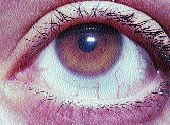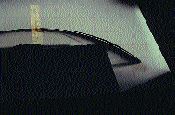Simplifying Custom Toric Soft Lens Specification
Toric lens dsigns is no doubt an arduous task, but Biocompatibles promises product accuracy and practitioner ease with the formula it uses to optimize the new Proclear Tailor-Made-Toric lens.
BY DAVID CAMPBELL-BURNS, FCOptom, FACLP, & FRANK R. TOSCANO, OD
JULY 1998
Nothing is better for your practice than refitting previously failed toric soft contact lens wearers, especially when the failure was caused by inadequate vision associated with poorly fitted, unstable lenses. Mastering the art of toric contact lens fitting is also in your best interest because many patients have more than 1.00D of astigmatism and are willing to pay more for better vision. Plus, by fitting custom torics, you reinforce your role as a professional in a climate where consumer awareness of clinical skills is vital.
|
Since the first commercial soft toric products appeared in the 1970s, progress has been slow in terms of simplifying fitting procedures and increasing the accuracy and reproducibility of the products. Modern manufacturing methods have greatly improved product consistency, but the result has traditionally been a restricted parameter range. In contrast, the recently introduced Proclear Tailor-Made-Toric lens (Biocompatibles Eyecare, Inc.) offers a generous array of parameter increments (Table 1). Tailor-Made-Toric is a back surface toric lens made from the same 59 percent water content omafilcon A material as Proclear and Proclear Compatibles spherical contact lens designs.
|
Resolving Fitting Complexities
Most laboratories offer custom designs on a guaranteed-fit basis, so even the most complex fits can be attempted. On the downside, multiple exchanges are often required, increasing manufacturer costs and patient/practitioner chair time. Manufacturers have devised various clinical strategies for achieving a satisfactory fit, including large fitting sets to provide a trial lens that would ideally mimic the on-eye performance of the finished lens. However, an adequate profile of lenses is costly, and the final prescription lens often moves or rotates differently than the trial lens anyway. Table 2 lists other ways manufacturers have addressed these inherent toric lens fitting complexities, although most of these options are flawed because they don't properly coordinate the highly interdependent variables of fit, power and rotation. Remember -- there is little point in attempting to correct for lens rotations if the fit has not been optimized.
|
The TMT Philosophy
When prescribing a toric soft lens, your initial challenge is to select the appropriate base curve and diameter. An ideal solution would be for you to supply accurate but simple-to-determine data to the manufacturer, who would then supply a custom lens that's comfortable and gives good, stable vision when fitted correctly. The object of the Biocompatibles TMT Program is to make fitting a custom toric soft lens as straightforward as fitting a stock design, but with greater flexibility. In addition to providing an optimal fit, the resultant contact lens should incorporate all predictable power corrections.
Although our post-market studies have shown that practitioners are far more inclined to vary the base curve when altering fitting characteristics, lens diameter remains the key dimension in the control of lens fit. The lens diameter is derived from the corneal diameter but, even with eyepiece reticules in the slit lamp, taking this measurement is difficult. With practice, a hand-rule with half-millimeter vernier engravings can yield good results, but a standard millimeter scale is useless.
It is well known that steep corneas tend to be small and flat corneas tend to be large. Mean values are 7.8mm (43.00D) for the central K readings and 11.5mm for the corneal diameter. However, we were unable to find any recent published study containing comprehensive data on the relationship between K readings and HVID (horizontal visible iris diameter). Furthermore, effective corneal diameter (ECD), not the HVID, is the significant corneal diameter dimension for prescribing soft contact lenses.
The TMT program calculates the diameter and base curve of each Tailor-Made-Toric lens from a predicted ECD. This ECD varies from the HVID by a small but clinically significant amount. The HVID doesn't account for the difference between the point at which corneal physiology changes to scleral physiology (clear to white tissue) and the location of the sulcus where the geometry changes. Although the difference may be only 0.2mm to 0.4mm, there is a significant difference between a contact lens diameter of 14.20mm and one of 14.60mm (see Case History #1).

Other factors affecting lens movement and orientation are peripheral corneal topography, lid pressure and lid angle. The peripheral cornea can be assessed with the new videokeratographers, but these are not yet sufficiently widespread for the manufacturer to request these patient data. Lid factors cannot be quantified in the normal practice environment.
How It Works
Based on measurements of 250 eyes, we constructed a data table demonstrating the relationship between mean K and ECD, as well as the incidence and distribution of unusual individuals. Allowing for an average bandwidth of flexure, i.e., the amount by which the finished lens can be either steep or flat and still furnish a satisfactory fit, we were able to predict ECD from the mean K for over 90 percent of the data points. The remaining data points represented corneas that were either unusually large and steep or small and flat. Plotting a mean regression line through the data yielded the following gradient expression: y = mx + c. This gradient allows the difficult-to-measure ECD to be derived from the easy-to-measure K readings. From this data, the lens designer can extrapolate an ideal base curve and diameter for each patient. The resulting lens will have a higher probability of achieving a successful first-time fit than any comparable method, other than a very large fitting set in the hands of a very experienced practitioner (see Case History #2).

Our manufacturing facility has noted that many requests for altered fits specify changes which are too small to have a significant effect. Changes should be at least 0.30mm to 0.50mm for the diameter and 0.20mm to 0.40mm for the base curve.
Optimizing Power
Another task that the lens designer faces is identifying all of the clinically significant variables that affect the power of the finished lens on the eye. The variables include:
Back Vertex Power -- Tables and equations for compensation are widely available and used in both spectacle and contact lens practice. It is highly significant for powers greater than �4.00D.
Thickness -- Many spectacle and contact lenses are treated as thin lenses for most calculation purposes, but toric soft contact lenses soon become thick enough in certain meridians for power correction to be appropriate. Equations for correction are available in Douthwaite's book, "Contact Lens Optics and Lens Design," (1995). Thickness becomes a significant factor above 0.1mm.
Drape -- Power changes due to alterations in the base curve have been well documented in the literature. They are best explained here by considering the effect of a lens base curve of 8.6mm draping to fit a cornea of 7.8mm. Drape is significant at all powers.
Flexure -- This effect on lens power occurs when the toricity of the cornea differs from the toricity of the lens back surface. These corrections are the most complex to compensate. Again, refer to Douthwaite for the arithmetic.
Refractive Interface -- These power effects, together with the tear lens power, account for a small negative overcorrection over the power range.
Rotation -- Textbooks and fitting guides refer to an average contralateral (bilateral, nasal) rotation of five degrees as being the norm. Unfortunately, the intersubject variation is so great that Biocompatibles decided to not incorporate it into the program. For clarity, rotation should be described as "clockwise" or "counter-clockwise" because this does not vary from OD to OS, unlike the terms "nasal" or "temporal." Figure 1 identifies the direction of the rotation based upon the direction in which the 6 o'clock lens marking moves.
According to the criteria Biocompatibles adopted, any variable having a magnitude greater than �0.06D over the specification range likely to be offered is considered significant. The logic was that the total of uncompensated errors of this magnitude would easily account for an error of 0.25D when occurring in the same direction. Over much of the power range, this is equal to ISO (or ANSI) tolerances. All of the above power variables are compensated in the TMT program.
Post-Market Analysis
An analysis of specification changes requested under the company's TMT exchange program revealed interesting data on the program's performance and on practitioner preferences. It soon became evident that the lenses were being prescribed for a large number of previously failed cases and that this had a negative effect on the success rate. A significant number of requests for specification changes did not materially change the sagittal height, but reflected each practitioner's preferences for a certain style of fit. The greatest difficulty was in resolving complex overrefractions associated with rotations. Our consultants assessed a number of commercially available programs which compensate for the power effects of rotation and resolve the residual values. Since none exactly suited their needs, the company developed a specially written program which is simple to use and has an appropriate level of rounding.
We analyzed 200 lens exchanges from Biocompatibles' production and ordering system; Table 3 shows the results. It's interesting to note the relative proportion of changes to diameter and base curve radius. A previous study shows that, if a change in fitting characteristics is required, practitioners are far more likely to alter the base curve than the diameter. Of those changes, 92 percent of practitioners had not varied the diameter by a clinically significant amount, and 84 percent had not varied the base curve. Although most experienced toric fitters will first consider a diameter change to modify lens behavior, twice as many changed the base curve. Although based on an entirely different sample from the first study, the current data, shows a similar pattern. Seven percent of practitioners changed the base curve and diameter, while 12.5 percent modified the base curve, and 31 percent of the diameter changes were for 0.20mm or less! Not only were many changes well below a value that would have a significant effect on fit, but according to current ISO proposed standard tolerances, the manufacturer could send the same lens back.
|
Evaluating TMT Efficacy
A recent study (awaiting publication) compares the clinical effect of the TMT program in the hands of an inexperienced toric fitter against that of a fitting set used by a highly skilled practitioner. Although the absolute specifications may differ, the TMT fits would be acceptable in most cases. Additionally, the experienced fitter achieved a success rate with the TMT program similar to that with a fitting set. However, it may be beneficial to demonstrate to patients the comfort achieved with a toric soft trial lens (Figs. 2 & 3).
|
The evolution of technology for the design and manufacture of toric soft lenses combined with the TMT optimization program brings us to a new age of toric soft lens precision fitting. The parameters for the initial lenses ordered can now be based on a program backed up by statistical data rather than by estimates from either the laboratory or the practitioner. Plus, the practitioner doesn't have to worry about the availability of a required parameter when a second lens is needed to optimize the fit. In other words, the fitter will not have to change manufacturers to obtain a certain base curve and diameter combination.
To receive references via fax, call (800) 239-4684 and request document #38.
David Campbell-Burns is Technical Services Manager of Biocompatibles Ltd., working
in Farnham, England, and Norfolk, Virginia. He is in private practice in Marlow, England.
Dr.Toscano is an experienced investigator and author and is in private practice in
Virginia Beach, Va.






